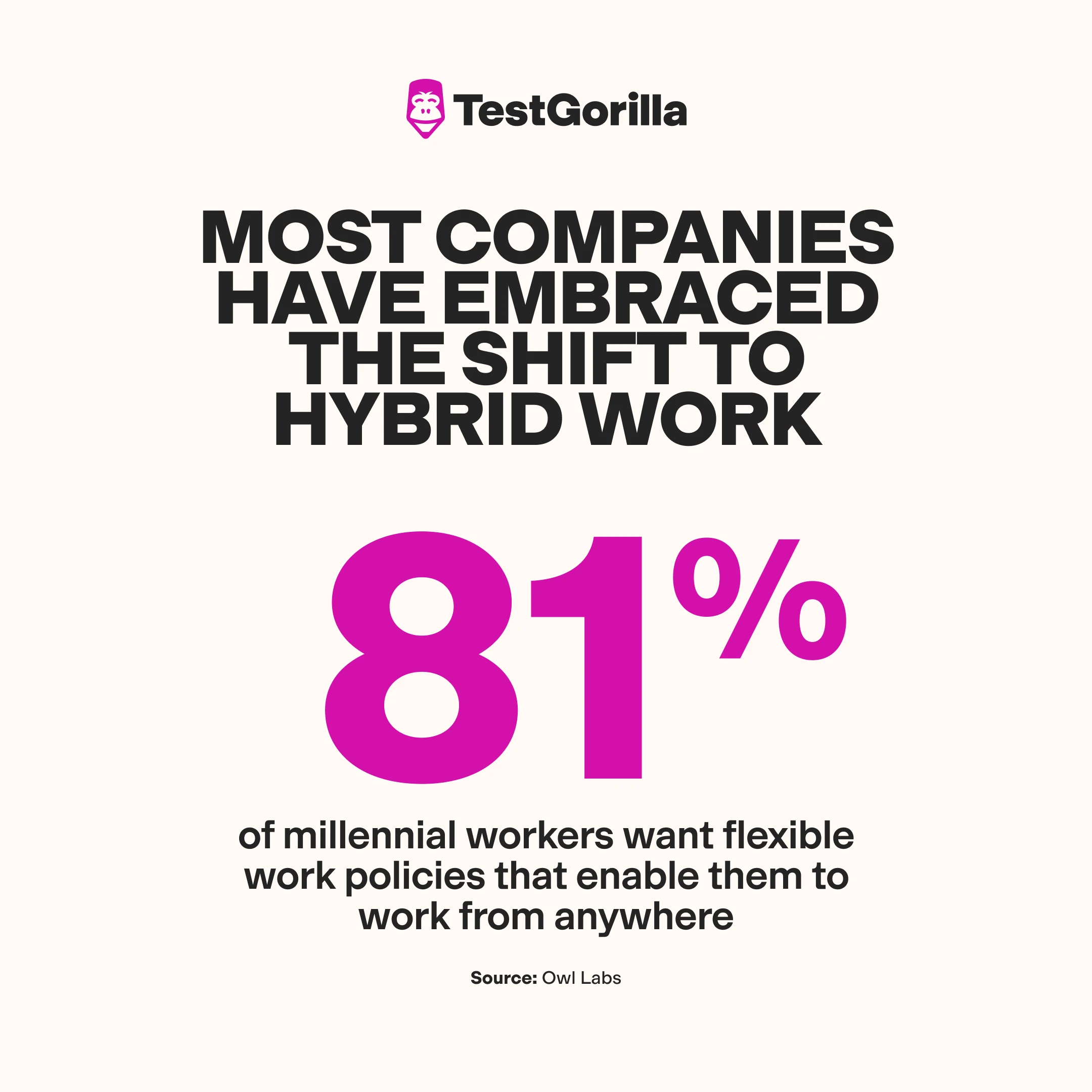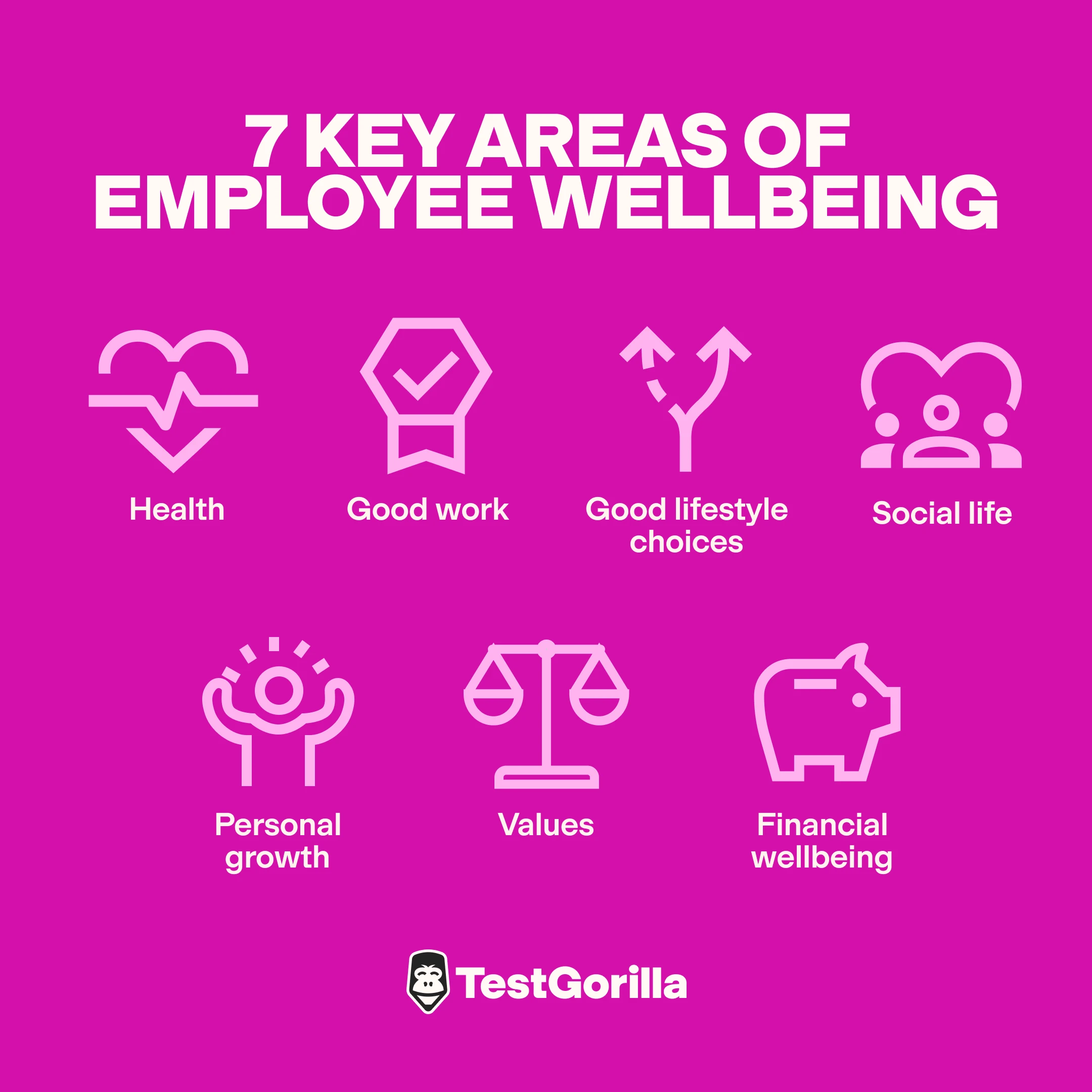Top 10 recruiting trends for the future of hiring
Use talent assessments to get ahead of recruiting trends
Outdated hiring practices often overlook the full spectrum of candidates’ skills. In addition, traditional recruitment practices are often slow and biased, making it difficult to find the right talent.
These problems leave companies with workforces that are less diverse, innovative, and adaptable than they should be.
In this article, we explore how to solve these issues with emerging recruiting trends, such as focusing on skills, using technology, and giving candidates what they want.
Let’s dive into how these recruitment trends help you attract and retain the best candidates
Table of contents
10 recruiting trends steering the future of hiring
The top trends in recruiting are reshaping the way companies connect with talent. The current trends in recruitment and selection are all about innovation, inclusivity, adaptability, and efficiency.
So, let’s see how these trends push for skills-based hiring and redefine how companies approach discovering and engaging with top candidates.
Summary of the most important recruiting trends
Trends in recruiting | Benefits |
1. Automation and AI | Improves hiring accuracy, reduces bias, and streamlines recruitment processes |
2. Skills-based hiring | Increases the quality of new hires, minimizes recruitment bias, and reduces hiring costs |
3. Flexible and remote work | Attracts top talent by supporting preferences for work-life balance and flexible schedules |
4. Data-driven recruitment | Optimizes hiring decisions and strategy through actionable insights and better candidate matching |
5. DEI | Drives innovation and enhances company culture by promoting diversity and inclusion |
6. Internal hiring and upskilling | Builds workforce capability and loyalty by developing existing employees’ hard and soft skills and promoting from within |
7. Candidate experience | Boosts candidate satisfaction and engagement, increasing offer acceptance rates |
8. Social recruiting | Expands reach by engaging potential hires on popular platforms |
9. Wellness and mental health | Promotes a healthier, more productive workforce by supporting employee wellbeing |
10. Employer branding | Attracts qualified candidates and influences their decision to apply based on company reputation and values |
1. Follow automation and AI recruiting trends
Automation and artificial intelligence support tracking, storing, and analyzing data during various stages of the hiring process. These current recruiting trends help avoid human error and bias and save time by eliminating manual, repetitive tasks.
So, how are AI recruiting trends helping HR professionals and business leaders find and hire better talent?
The most important thing is that AI makes applicant tracking systems (ATS) more useful.
Instead of relying on keywords to assess a candidate’s skills, AI-assisted ATS can interpret context to find talent with a skill set that better matches the job opportunity. It can also match previously rejected candidates with new roles that closely relate to their skill sets.
Another AI recruiting trend is using conversational AI chatbots to improve candidate communication. These chatbots answer common questions and help candidates avoid abandoning a job application due to a lack of clarity. This includes questions about who to contact, the next steps, or the status of their application.
Considering that 60% of job seekers quit during an online job application because it’s too long or complex, it’s clear how AI chatbots can help overcome this problem.
To improve recruitment automation, you can:
Prescreen candidates with skills tests
Focus on skills and traits to reduce bias
Streamline interviews by enabling easy scheduling and sending reminders to reduce no-shows
Use the time saved by automation to apply a human touch to tasks that require it, such as creating better job descriptions
Personalize automated templates to engage candidates
2. Use skills-based hiring
One crucial current trend in recruitment and selection is using skills-based hiring instead of relying on resumes and education.
That’s because skills-based assessments show when a candidate’s skills match what the recruiting team is looking for. This shift in mindset can eliminate hiring bias, broaden the candidate pool, and help you avoid mis-hires.
Experts create skills tests to evaluate candidates based on their unique skill sets. Companies choose which tests to use based on the role they’re hiring for. Then hiring managers analyze the results, compare candidates, and make hiring decisions based on data.
For example, if you work in a tech company searching for the next AI product manager, you can use TestGorilla’s AI Product Manager test. It helps you evaluate candidates on key skills such as AI fundamentals, product strategy, and ethical considerations in AI.
This test can help you find a candidate with the right skills to steer AI product development in alignment with the company’s vision.
The best thing is that you can combine up to five different skills tests in one comprehensive assessment. So, you can add our Problem Solving test or other tests to identify and secure the best candidates.
Using talent assessments is also one of the leading campus recruiting trends because these tools can help you identify skilled students or graduates for entry-level positions.
Our recent survey shows that 92% of employers think skills-based hiring is great for identifying better talent. It has several other benefits, including:
74% reduced hiring costs
82% reduced time-to-hire
88% fewer mis-hires
89% better employee retention
84% improved diversity
Our clients have seen these results firsthand. Take Revolut, for instance. This financial organization struggled to find the right candidates due to a long and tiring recruitment process.
With TestGorilla’s help, the company reduced time-to-hire by 40%, enhanced the candidate experience, and improved the quality of candidates that advanced to the interview stage.
If you want to learn more about how to use our talent assessments to get the most out of current recruiting trends, book a free live demo.
3. Offer flexible and remote work
Most companies have embraced the shift to hybrid work because that’s what employees prefer. In fact, 81% of millennial workers want flexible work policies that enable them to work from anywhere.
Adopting a flexible working policy can attract the best talent by showing that you:
Care about your employees’ work-life balance
Are willing to innovate with how you conduct business
Give your workforce autonomy and empower them to direct their own work
Your organization can adopt many flexible working policies. For example, you can offer unlimited vacation days or a compressed working schedule, such as the 9/80 work schedule or the four-day work week.
Offering flexible and remote working policies can open up your talent pool to a diverse range of job applicants and support your employees’ mental health and performance.
However, it’s important to establish some ground rules and protocols to ensure your employees stay productive in remote and hybrid environments. That includes:
Implementing digital tools for communication and collaboration
Establishing clear expectations around availability and deliverables
Focusing on outcomes rather than hours worked
Encouraging regular check-ins and virtual team-building activities to maintain engagement and connection
Providing support and resources for home office setups to ensure productivity
4. Use data-driven recruitment
With the rise of technology in the recruitment process, there is an increase in candidate data available. For hiring managers, that means they can analyze and gather insights to help them choose the right candidate for the role and improve recruitment for future hires.
Data is no longer limited to traditional demographic and performance metrics. Instead, it is a strategic asset that supports workforce improvement, skill innovation, and company culture.
For example, Visionaries, a game development publishing studio, used TestGorilla to create a data-driven hiring process. By incorporating talent assessments into the hiring strategy, the company managed to build a team of exceptional talent. In addition, it saved around 15 hours per hire.
Implementing a data-driven recruitment strategy helps avoid bias, contributing to a diverse and inclusive workplace environment. Here’s how to do that:
Use analytics to understand key recruitment metrics like time-to-hire and hiring channel effectiveness
Explore labor market data and benchmarks to create realistic and competitive job ads
Use talent assessments to quantitatively evaluate and compare candidate skills
Employ predictive analytics to forecast future hiring needs and talent pool trends
Regularly review and adjust your hiring strategies based on data insights to continually improve the recruitment process
Unlock the power of talent assessments with TestGorilla
Use our talent assessments to avoid bias, reduce time to hire, and improve recruiting efficiency.
5. Encourage and embrace DEI
Encouraging and embracing diversity, equity, and inclusion (DEI) is one of the growing trends in recruitment, reflecting a societal push toward equality and representation in the workplace.
Diverse perspectives are crucial for innovation and decision-making, which is why more companies are focusing on these early talent hiring trends. This is important because 80% of young workers consider a company’s DEI initiatives when choosing a new job.
To encourage and embrace DEI in recruitment, you can:
Implement blind recruitment processes to minimize bias
Use skills assessments to evaluate competencies objectively
Develop diverse hiring panels to bring multiple perspectives to the selection process
Offer diversity training for recruiters and hiring managers
Set and track measurable DEI goals to guide progress
Create partnerships with diverse professional organizations to widen your talent pool
6. Focus on internal hiring and upskilling
Instead of hiring new talent to tackle business issues, employers have realized that focusing on internal mobility or upskilling usually produces better results.
According to a report by PwC, 40% of companies currently upskill employees.
Upskilling good employees is a great idea because you already know they are capable and understand how your company works. As a result, it can fill a skill gap more quickly and cost-effectively than external hiring.
Upskilling can also:
Improve employee engagement due to new challenges
Increase employee retention by providing career development opportunities
Create a culture of continuous learning and improvement
Support a capable workforce that evolves with industry changes
Developing new skills unlocks the hidden talents of your workforce, which can open doors for internal hiring. That way, you can fill roles with familiar faces that bring fresh perspectives.
The Society for Human Resource Management (SHRM) found that employees who were promoted within three years were 70% more likely to stick around, and those who moved sideways into other roles weren’t far behind.
7. Improve candidate experience
A reported 85% of job seekers consider responsiveness during the application process as an “important” or “very important” factor when deciding whether to join a team. That’s why it’s crucial to make each step of the journey as informative and enjoyable as possible.
One of the early talent recruiting trends we commonly see is treating candidates more like customers in the coming year. That means creating a positive candidate experience from the start of the hiring process.
For instance, before using TestGorilla, SD Worx used another tool to evaluate the candidates during hiring. However, the tests took around three hours to complete, and the platform's interface wasn’t the best. As a result, the candidate’s experience suffered.
After switching to TestGorilla, the company saw a significant improvement in the completion rates of talent assessments and overall candidate satisfaction.
You can embrace these recruitment trends and create a great candidate experience by:
Streamlining the application process so that the application form is short
Including the salary range in the job ad
Giving candidates regular updates and detailed feedback at each stage of the application process
Being as flexible as possible when it comes to interview times
8. Try social recruiting
If you want to get ahead of recruitment marketing trends, you should use social media, not just job boards, to attract employees and reinforce the brand’s identity and culture.
Social media platforms are powerful recruitment tools for reaching a younger pool of candidates. According to a study by CareerArc, 48% of Gen Z and millennial workers have applied for a job they found on social media.
These platforms are also great places for companies to communicate brand values. For example, if you check Spotify’s Instagram, you’ll see a ton of content dedicated to the company's working life.
The account shares stories from people who grow the product and talks about diversity, equity, and belonging. This content shows how the company practices and lives its diversity values.
Social media is one of the most important recruitment marketing trends because it can build a bridge between a company and potential candidates by showing its culture, values, and work-life.
That’s why businesses are experimenting with new recruitment tactics that meet young workers in a place where they already spend time, like TikTok.
For example, Chipotle, a major Mexican food chain, leveraged its 2.1 million followers on TikTok to recruit 15,000 employees. The company partnered with TikTok and used the hashtag #TikTokResumes to use current recruitment marketing trends and hire employees through video applications on the platform.
9. Consider wellness and mental health
Employee wellbeing is more than just how employees feel on the clock. You also need to support employees to thrive in their personal lives by promoting good mental and physical health outside of work, positive lifestyle choices, and full social lives.
Keep in mind that remote work can bring some challenges, such as social isolation and a less active lifestyle. These could build up to culminate in the phenomenon known as working-from-home depression.
Happy and healthy employees are more engaged and productive, which is why you need to consider their mental health and overall wellness. You can do that by:
Offering flexible work to improve employee experience
Providing access to mental health resources and counseling services
Encouraging regular breaks and promoting a healthy work-life balance
Creating an open and supportive culture where employees feel safe discussing mental health
Organizing wellness programs and activities that focus on physical and psychological wellbeing
10. Improve employer branding
Employer branding defines how potential candidates perceive your business. It includes things like:
What you stand for
What it’s like to work for you
What candidates stand to gain by working for you
For example, Google has one of the strongest employer brand messaging out there. It’s known for creativity, learning, and innovation, so even before applying, candidates know to expect:
A rigorous selection process
A fast-paced working environment
Working with highly qualified and creative colleagues on innovative projects
Opportunities for learning and development
A flexible working culture
Google broadcasts its brand in numerous ways, including its “Life at Google” YouTube channel, where the company posts videos on topics including the hiring process, the impact that individual “Googlers” make, and the “Ask A Googler” series.
According to the Edelman Trust Barometer study, 60% of people choose a place of work based on their beliefs and values. That means that when top talents choose between you and a competitor, the decision can come down to your brand’s reputation and values.
Employer branding is also important for attracting candidates to your company in the first place. If you’re well known for giving employees upskilling opportunities and promoting from within, ambitious candidates are likely to look for job postings from your organization.
Get ahead of recruitment trends with TestGorilla
The world of hiring has changed, and you need to embrace early talent recruiting trends to find the best candidates.
This means improving candidate experience, using data-driven processes, and embracing DEI – all of which you can do by using talent assessments to measure the skills and traits of your candidates.
Take a product tour to discover how you can use our skills assessments to identify the best candidates.
Or book a free live demo to learn more about our personalization and customization options.
Finally, you should sign up for a free account to enter the future of hiring today.
Current recruiting trends FAQs
Do you still have questions about current trends in recruitment and selection? Find your answers below.
What are the most frequently used methods of recruiting?
Employee referrals tapping into current employees’ networks
Online job postings on platforms like LinkedIn and Indeed
Social media campaigns to engage candidates through targeted content
Recruitment agencies specializing in talent sourcing
Company career websites
Industry events and job fairs for direct engagement
Professional networks and forums for specific niches
Internal job postings
How is recruiting changing?
Recruiting is mostly shifting toward automating processes and finding more objective ways to evaluate candidates’ skills. The traditional resume-based approach is giving way to skills-based hiring, with a focus on DEI. Remote and hybrid work are pushing companies to adopt more flexible, digital-first approaches. Creating a candidate experience has also become crucial because companies now understand how hard it is to secure top talent.
Why is recruiting so hard now?
Recruiting is so hard now due to a competitive job market where job seekers have more options and expectations. Advances in technology and machine learning, shifts toward flexible work, and the demand for more diversity and inclusivity have broadened the talent pool and made hiring strategies more demanding. These make the hiring process more complex but more rewarding for companies that adapt effectively.
What is next in talent acquisition?
The future of talent acquisition trends is going toward more personalized, candidate-centric processes. That includes using AI and data analytics for deeper insights, better candidate engagement, and higher efficiency. Other recruiting trends that can become more long-term include skills-based hiring and DEI initiatives, ensuring more strategic, inclusive, and technology-driven recruitment.
Related posts
Hire the best candidates with TestGorilla
Create pre-employment assessments in minutes to screen candidates, save time, and hire the best talent.
Latest posts
The best advice in pre-employment testing, in your inbox.
No spam. Unsubscribe at any time.

Hire the best. No bias. No stress.
Our screening tests identify the best candidates and make your hiring decisions faster, easier, and bias-free.
Free resources
This checklist covers key features you should look for when choosing a skills testing platform
This resource will help you develop an onboarding checklist for new hires.
How to assess your candidates' attention to detail.
Learn how to get human resources certified through HRCI or SHRM.
Learn how you can improve the level of talent at your company.
Learn how CapitalT reduced hiring bias with online skills assessments.
Learn how to make the resume process more efficient and more effective.
Improve your hiring strategy with these 7 critical recruitment metrics.
Learn how Sukhi decreased time spent reviewing resumes by 83%!
Hire more efficiently with these hacks that 99% of recruiters aren't using.
Make a business case for diversity and inclusion initiatives with this data.
























